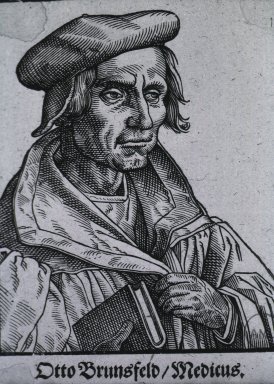Otto Brunfels
Image courtesy of the U.S. National Library of Medicine, History of Medicine Division
Otto Brunfels was born near Mainz, Germany in 1488 or 1489. He served as a monk in a Carthusian monastery in Strasbourg (today on the French-German border) from 1514 to 1521. In 1521 he converted to Lutheranism. Following his conversion, he became a schoolmaster and preacher in Strasbourg. As a preacher he wrote theological works. In 1530 he entered the University of Basel to study medicine. In 1532 he was named the town physician of Bern, Switzerland. Around 1532 he made a journey from Strasbourg to Hornbach to urge Jerome Bock to write a botany book in the German language. Brunfels died in 1534.
Title page of Brunfels' Herbarum Vivae Eicones
Brunfels wrote Herbarum Vivae Eicones from 1530-1536. This copy was published in 1536 and written in Latin. The book’s revolutionary idea to include new botanical illustrations drawn from nature helped botany become a separate discipline. But, Brunfels used existing information from classical and medieval authors, some of which was inaccurate. Gill Saunders writes, “Ironically Brunfels himself dismissed the illustrations as no more than ‘dead lines,’ convinced that they were inferior to the ‘right-truthful descriptions’ in his text” (Picturing Plants, 20). However, he was the first botanist to give equal interest to wild plants. Brunfels worked on the book in his leisure time and intended it to be used by scholars. Brunfels organized the herbal by the medicinal use of the plant. He used the plants’ common German names, which was a new idea.
Red Poppy featured in Herbarum Vivae Eicones
Hans Weiditz created the revolutionary illustrations for the herbal. He painted specific plant specimens from nature without idealizing them. This was unique in herbal history. Subsequent herbals, beginning with Fuchs’ De Historia Stirpium, included generalized illustrations that looked like ideal specimens without flaws. These artists drew perfect specimens to show a characteristic example of each species.
Call Number: Iowa State University Library Special Collections QK41 .B835h
